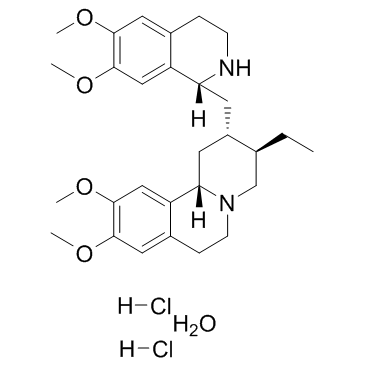7083-71-8
| Name | (2S,3R,11bS)-2-[[(1R)-6,7-dimethoxy-1,2,3,4-tetrahydroisoquinolin-1-yl]methyl]-3-ethyl-9,10-dimethoxy-2,3,4,6,7,11b-hexahydro-1H-benzo[a]quinolizine,hydrate,dihydrochloride |
|---|---|
| Synonyms |
Emetine,dihydrochloride,hydrate
Emetan,6',7',10,11-tetramethoxy-,dihydrochloride,hydrate 6',7',10,11-tetramethoxyemetan dihydrochloride hydrate Emetine hydrochloride hydrate Emetine dihydrochloride hydrate |
| Description | Emetine dihydrochloride hydrate is an anti-protozoal drug previously used for intestinal and tissue amoebiasis. |
|---|---|
| Related Catalog | |
| In Vitro | Emetine dihydrochloride hydrate is reported to have an IC50 value of 1 nM on the drug sensitive 3D7 P. falciparum parasite strains. Dose response curves are determined for both drugs using K1 resistant isolates and IC50 values of 47±2.1 nM and 2.6±0.41 nM established for emetine dihydrochloride hydrate and DHA, respectively[1]. After the lymphoblasts are treated with cycloheximide or emetine dihydrochloride hydrate, the expression level of the mutant allele is elevated almost equally to the wild-type alleles by direct sequencing of the corresponding cDNA[2]. Emetine is identified as a lead compound with significant concentration dependent suppression of PEDF-induced TNF secretion and an IC50 of 146 nM. Emetine inhibits PEDF-mediated TNF release without affecting cell viability. Emetine binds to PEDF receptor ATGL with high-binding affinity (KD=14.3 nM)[3]. Emetine treatment reduces cell viability, induces apoptosis, promptes AML cells towards differentiation and downregulates HIF-1α[4]. |
| In Vivo | Emetine (0.002, 0.02, 0.2 and 2 mg/kg) does not induce any significant difference in body weight in mice with low-dose streptozotocin model of T1D. Administration of emetine not only attenuates blood glucose levels in dose-dependent way but also induces a persistent attenuation of blood glucose levels. Daily administration of emetine dose-dependently attenuates hyperglycemic response by d 21. Consistent with this observation, administration of emetine, but not the vehicle control, results in a sustained attenuation of blood glucose levels. Emetine improves disease severity in a spontaneous model of NOD T1D[3]. Emetine (1 mg/kg) reduces both leukemia burden in an in vivo xenotransplantation mouse model and the clonogenic capacity of leukemic cells upon treatment[4]. |
| Cell Assay | 7.5×105 cells per mL are cultured in 96-well plates in complete medium. Emetine and Ara-C are added at indicated concentrations. Cell viability is measured by 7-AAD exclusion and Hoechst33342 positivity staining by flow cytometry; and cell count is obtained by volume in a FACSCantoII cytometer. Statistical analysis and EC50 determination are calculated in GraphPad. FlowJo software is used for flow cytometry analysis. |
| Animal Admin | T1D is induced by administration of streptozotocin (50 mg/kg dissolved in sodium citrate buffer, pH 4.5) to 6 to 8 wk old C57Bl/6 mice intraperitoneally (i.p.) once each day for 5 consecutive days. Mice are given water supplemented with 10% sucrose for six days to prevent sudden hypoglycemia during streptozotocin administration. For time course studies, body weight and blood glucose are measured every other day. Blood glucose is measured with a FreeStyle Lite blood glucose meter. For studies with emetine, mice receive daily administration of emetine dihydrochloride (0.002, 0.02, 0.2 and 2 mg/kg) or saline. Blood glucose with either FreeStyle Lite blood glucose meter or Bayer Contour blood glucose meter and body weight are measured once weekly. At the end of each study, mice are euthanized by CO2 asphyxiation. Blood and pancreas are collected for cytokine analysis. |
| References |
| Molecular Formula | C29H40N2O4.2HCl.H2O |
|---|---|
| Molecular Weight | 571.58 |
| PSA | 61.42000 |
| LogP | 6.74980 |
| Symbol |

GHS06 |
|---|---|
| Signal Word | Danger |
| Hazard Statements | H300-H315-H319-H335 |
| Precautionary Statements | P261-P264-P301 + P310-P305 + P351 + P338 |
| RIDADR | UN 1544PSN2 6.1 / PGI |
